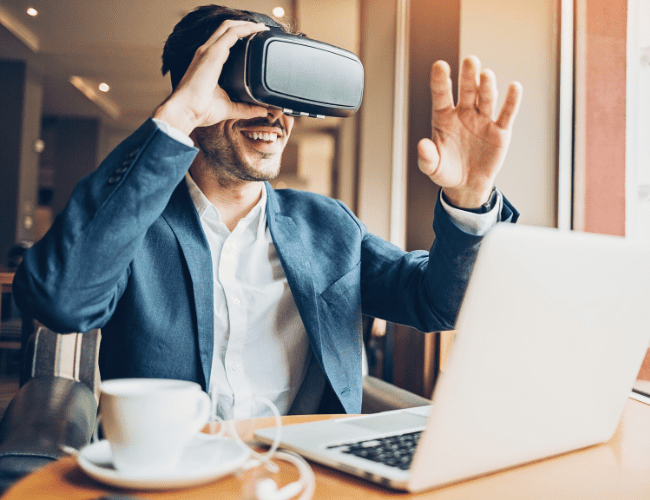As the digital era continues to evolve, so does how businesses engage with their audience through visual communication. Visual content is a crucial component of any successful digital marketing strategy today. From simple graphics to immersive experiences powered by virtual reality (VR) and augmented reality (AR), the modern consumer demands highly interactive and personalized visuals. This shift has driven digital marketing agencies to rethink their approaches, making visual communication more dynamic, adaptable, and engaging.
How Digital Media Transformed Visual Communication
Traditional visual communication, often delivered through print or television ads, was slow to produce, static in concept, and costly to modify. Once a campaign was launched, making changes was time-consuming and expensive. Moreover, traditional media typically used generic messaging designed for broader audiences, limiting the potential for targeted engagement.
With the rise of digital media, businesses have gained unprecedented control over their visual content. Digital platforms allow for quick production, rapid modification, and the ability to target specific demographics with tailored messages. This flexibility enables brands to respond swiftly to consumer feedback, emerging trends, or market shifts.
Companies can craft content that speaks directly to their audience’s preferences, behaviors, location, medium, and past interactions instead of generic, one-size-fits-all visuals. Businesses can harness visual content to achieve more personalized and immersive engagements with their audiences.
Personalized Visual Communication
Personalization has become the cornerstone of digital marketing strategies. Consumers today expect brands to supply content tailored to their interests, reflecting their preferences, behaviors, interests, and even their past interactions. Platforms like social media allow brands to target specific audience segments, making it easier to deliver personalized visuals that resonate on a deeper level.
Instead of serving a generic ad to a broad audience, for example, a brand can create multiple versions of an ad that cater to different demographics. This kind of personalization builds a stronger connection between the brand and its target audience.
Additionally, digital platforms enable brands to track real-time analytics, allowing them to see how their content performs across different demographics. Brands can quickly pivot or refine their content to better meet audience expectations, making visual communication in the digital age more dynamic and data-driven.
The Rise of Interactive Content

Interactive content has emerged as a crucial tool for engaging consumers. Unlike traditional media, where visuals were static and passive, digital media invites users to engage with content in new ways. Interactive content, such as quizzes, polls, and immersive AR/VR experiences, allows users to participate actively rather than passively consume the information.
Many top digital marketing agencies have successfully used interactive visuals to increase engagement and conversion rates. By allowing users to participate in the brand experience, interactive content helps create a more memorable and impactful connection.
For example, augmented reality marketing is becoming increasingly popular as a way for brands to offer unique, immersive experiences. A beauty brand might use AR to let users virtually try on makeup products, and a real estate company might offer virtual home tours through VR. These technologies are highly engaging and effective in driving conversions.
Interactive content has several benefits:
- Enhanced Engagement: Encouraging users to interact with content rather than view it keeps them engaged longer.
- Improved Conversion Rates: By creating engaging experiences, interactive content often leads to higher conversion rates, as users are more likely to take action.
- Memorable Experiences: Interactive and immersive content tends to leave a lasting impression, increasing brand recall and loyalty.
Building a Strong Visual Brand Identity Across Platforms

A cohesive visual brand identity is essential for businesses seeking to create a lasting impact in the digital space. Through social media marketing, websites, or email campaigns, the opportunity to maintain consistent visuals ensures that consumers recognize the brand instantly, no matter where they encounter it.
However, consistency in visual identity means something other than stagnation. Brands should remain flexible and adaptable, updating their visual content to reflect current trends and consumer expectations while maintaining their core brand identity. This balance between consistency and adaptability is critical to maintaining relevance in today’s fast-paced digital world.
Elements of a Visual Brand Identity
Several elements are essential for building and maintaining a strong visual brand identity across various platforms:
- Consistency: Visual elements such as color schemes, typography, and imagery should remain uniform across all platforms to ensure brand recognition.
- Relevance: While consistency is important, updating visuals to align with current trends and market shifts is equally essential.
- Adaptability: Brands should be flexible enough to adapt their visual content to suit different platforms. It ensures that the messaging resonates with each platform’s unique audience.
A successful digital marketing company understands the importance of balancing these elements in order to create a brand identity that is both consistent and adaptable. Businesses can effectively communicate their message across platforms while ensuring their brand remains recognizable and relevant.
Visual Storytelling: Connecting Emotionally with Audiences
Visual storytelling is one of the most effective ways for businesses to engage with their audience. Using visuals to tell a story, brands can connect emotionally with their audience, fostering loyalty and encouraging deeper engagement. Rather than simply promoting products or services, visual storytelling allows businesses to convey their values, mission, and personality more relatable and engagingly.
Today’s consumers are increasingly drawn to authentic and emotionally driven content. They seek out brands that align with their values and experiences, making emotional storytelling a powerful tool for building brand loyalty. Authentic visuals that show the human side of a brand often resonate more with audiences than polished, overly produced content. As a result, many brands have shifted their focus towards creating more genuine, human-centered visuals.
Measuring the Success of Visual Communication
The beauty of digital platforms lies in their ability to measure the success of visual communication in real-time. Brands can track a range of metrics that offer insight into how their visuals are performing, including engagement rates, conversion rates, and the amount of time users spend interacting with visual content. By analyzing these key performance indicators (KPIs), businesses can determine which visuals resonate with their audience and refine their approach accordingly to strengthen a campaign’s return on investment.
Important Metrics to Track
When evaluating the success of visual communication, it’s essential to track certain metrics that provide insight into audience engagement and conversion. These include:
- Engagement Rates: This metric measures how many users are interacting with visual content through likes, shares, and comments. High engagement rates indicate that the visuals resonate with the audience.
- Conversion Rates: This tracks how many users take a desired action—such as making a purchase or signing up for a newsletter—after engaging with visual content. High conversion rates are a strong indicator that the visuals are driving results.
- Time Spent on Content: Monitoring how long users spend interacting with visual content, particularly immersive experiences like VR videos, helps measure the depth of engagement.
By tracking these KPIs, businesses can continually refine their visual strategies to ensure maximum engagement and effectiveness.
Future Trends in Visual Communication

Looking ahead, the future of visual communication is set to be shaped by emerging technologies like artificial intelligence (AI), machine learning (ML), and AR/VR. These technologies will enable businesses to create even more personalized, immersive, and dynamic visuals that resonate with their target audience on a deeper level.
AI will play a key role in enabling brands to deliver real-time, personalized visuals based on user behavior and preferences. AR and VR will continue to push the boundaries of immersive visual experiences, allowing brands to engage users in unique and memorable ways.
Additionally, there will be a growing emphasis on inclusivity and accessibility in visual design. As brands strive to reach a broader audience, ensuring that visuals are accessible to everyone, including those with disabilities, will become an important consideration.
Conclusion
As the digital landscape continues to evolve, businesses must stay ahead of the curve when it comes to visual communication. Partnering with a top digital marketing agency allows brands to leverage the latest tools and technologies to create visually compelling content that resonates with their audience.
By focusing on interactive content, embracing AI-driven personalization, and using authentic visual storytelling, brands ensure that their visual communication strategies drive engagement, conversions, and long-term brand loyalty. In the fast-paced digital world, businesses that prioritize effective visual communication will be best positioned to succeed.
